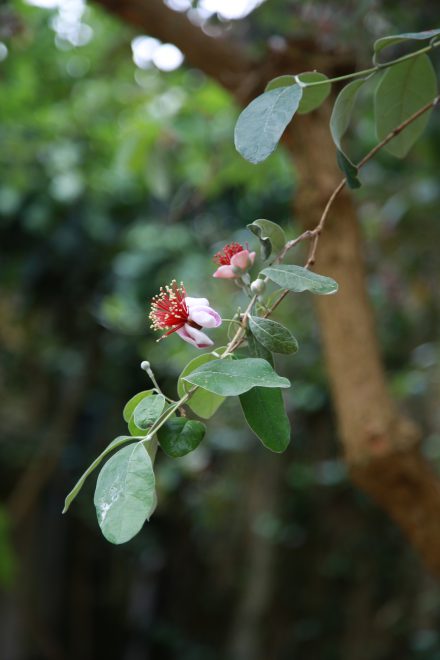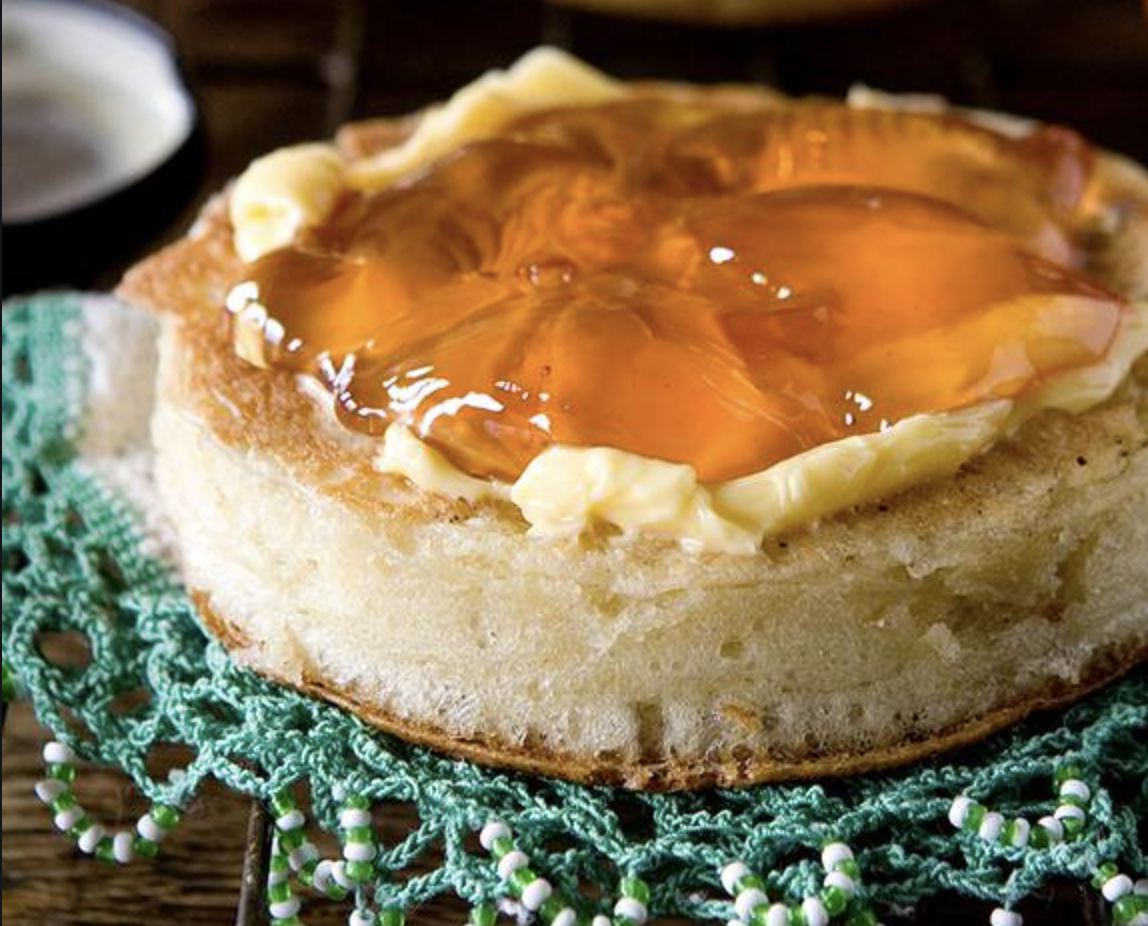Sweet, musky feijoa fruit (Latin name: Acca sellowiana) is native to the southern highlands of Brazil, Argentina, and Uruguay. The French botanist and traveler Edouard Andre introduced it to Europe in 1890.
The feijoa (said fey-joya) tree was first grown as an ornamental hedge for its beautiful red flowers, but people soon learned to enjoy the flavor of the exotic fruit.

The feijoa tree’s beautiful flowers.
Botanists improved the species. Eventually the tree made its way to other European countries, all the way to Russia and to the Far East. New Zealand leads the cultivation and export of feijoa, but now Israel and Turkey also boast of feijoa harvests.
It’s a hardy sub-tropical plant that yet needs a cold winter to fruit. The season is short, but in the right conditions, feijoa offers an abundant crop. Around this time of the year, magazines in Australia and New Zealand offer recipes for people who don’t know what to do with all the feijoa in their gardens.
In Israel, November and December are the months where it appears in markets. It has an oval, egg shape and a juicy inside with tiny seeds. Its fragrance reminds you of pineapple – feijoa is also known as “pineapple guava,” with a little strawberry or pear aroma in there somewhere.

A feijoa tree in France
The flesh should be white when ripe. Any sign of brown in the flesh means that it’s over-ripe. Feijoa doesn’t have a long shelf life; it only lasts two or three days after ripening. You have to be alert to get the best out of feijoa. Best if you forage it so you know it’s ripe and organic.
It’s tricky to pick it off the tree because you can’t be sure it’s ripe, but the tree lets you know when to harvest. When feijoa fruit is ripe, it falls. Gardeners must get up early and inspect the ground to see what fruit fell overnight. Once you collect a small pile, you can eat them, put them in the fridge or freeze with the skins off for shakes and freezes.
A little-known fact: the petals of the feijoa flower are edible and sweet. But you can’t pick off too many flowers, or your fruit crop will be disappointingly small.
Feijoa Muffin Recipe

Ingredients:
3 cups all-purpose flour
4 tablespoons baking powder
1 cup granulated sugar
3 large eggs
1 ¼ cups milk
1/2 cup peeled, finely diced feijoas
125 g – ½ cup unsalted butter, melted and cooled
A few spoonfuls of coarse sugar
Sift the flour into a large bowl. Whisk in baking powder and granulated sugar.
In a medium bowl, whisk the eggs and milk together. Gently fold the diced feijoas into the egg mixture.
Gently stir the egg mixture into the dry ingredients. Gently stir in the butter.
Divide the batter evenly between 12 cups of a well-greased or lined muffin pan. Sprinkle the tops with a little coarse sugar before baking.
Bake muffins at 220°C – 425°F for 15-20 minutes, until evenly baked. To test for doneness, poke a toothpick in the center of a muffin in the middle of the pan. When the muffins are fully baked, the toothpick will come out clean of crumbs.
Let muffins cool in pan for 5 minutes. Remove muffins from pan and transfer to cooling rack. Allow muffins to cool on rack for about 5 more minutes before serving.
From the A Delicious Moment blog
_______
Feijoa Jelly Recipe

Makes 2-3 small jars
Ingredients
5 pounds (2kg) feijoas
6 slices fresh ginger
Zest from ½ orange and lemon
1 cup sugar per 1 cup juice
Peel the feijoas and chop roughly into a large pot. Add the sliced ginger, orange and lemon zest. Fill with water to ½” – 1cm above the feijoas. Bring to a simmer for 10-12 minutes or until the feijoas are completely soft. If the feijoas are hard it may take a little longer.
Place a bowl under a strainer and line it with muslin. Carefully pour in the feijoas and juice. Gather up the sides and tie with string. Hang the muslin over the bowl, tying it high enough for the juice to drip slowly through. Do not be tempted to squeeze the muslin. Leave overnight to drain.
Next day, measure the juice into a clean pot. For each cup of juice add 1 cup of sugar. Slowly bring to a simmer, then boil gently for 15 minutes. Remove the scum from the top as it boils — it is ready when a little is tested on a saucer and it will almost set.
Pour into sterilised jars and store.
From Viva Magazine
Have a recipe to share? Reach out: [email protected]

